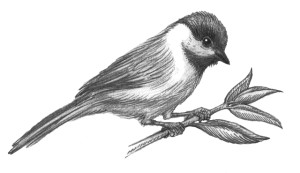Through The Garden Gate—December 2015
December Is For The Birds
By Leslie Watkins
It’s very nice to sit by a cozy fire with a cup of coffee and watch the birds on a snowy winter day. Brilliant blue jays, cardinals, and gold finches are a delight as they flit from perch to perch. They perform a carefully choreographed ballet, each taking its turn at the feeder. The jays lord it over the smaller birds, the quick chickadees dart in and out, and nuthatches hang upside-down. But the birds give you more than winter pleasure at your window. They may stay on to sing in springís dawn chorus and for summerís insect patrol in the garden.
In autumn, many birds gorge to build up a fat layer to help protect them in the freezing winter temperatures. They are busy hiding seeds in tree bark and crevices. Chickadees, titmice, and nuthatches will feed from these secret caches when their food supply is scarce. In winter, birds may lose 10 percent of their weight each night, shivering to maintain an average body temperature of 105 degrees. Little birds are at greater risk, because of their smaller core volume size relative to their surface area, than larger birds. Winter fruits and berries provide necessary fats and antioxidants. The late afternoon and early morning rush hour at the feeder makes a big difference to the survival rate of birds during severe cold spells. Providing birdseed and suet gives them the extra calories needed for maintaining body heat and for overall health. Studies indicate that birds given supplemental feeding also produce larger clutches.
There are squirrel-proof feeders available now that really do work. Look for ones with a mechanism that slides down with the squirrelís weight closing the feeding holes. Add a dome to keep the feeder dry and snow-free. Toss millet seeds on the ground for mourning doves, juncos, towhees and sparrows. To increase the variety of visiting birds at the feeding station add a thistle feeder for finches (also available with the squirrel-proof design) and suet cages for woodpeckers. For easy clean-up put down a layer of burlap under the feeders to catch sunflower seed hulls. In the spring, fold the burlap around the hulls and put both on the compost pile.
Hang feeders near branches to make the feeding area more attractive to birds. Many prefer to snatch a seed and take it to a nearby perch and crack it open. The birds are more comfortable with some overhead protection from hawks. Small trees, shrubs and evergreens can be worked into your garden design near bird viewing areas.
Window bird watching is entertaining for cats, too, but keep them inside. Cats are a serious threat to wild birds. Domestic and feral cats kill millions of wild birds each year. Help prevent this by keeping cats in, especially in the morning and just before sunset. Feral cats can be trapped humanely and brought to animal shelters, where they can be spayed or neutered.
Field test studies have shown that the most favored foods by birds are by far sunflower seeds and cracked corn, closely followed by peanut hearts, Niger (or Nyjer) thistle, and millet. Beware wasteful mixes that contain filler ingredients that are tossed aside and not eaten by birds. The best mix is homemade with the ingredients listed above.
For snowy spots that are hard to get to, but make good viewing from windows, leave plantings untrimmed with the seed-heads sought by birds intact to create an easy low maintenance bird feeding garden. Add trees and shrubs with winter interest like Cornus alba ‘Elegantissima,’ ilex verticillata (holly), malus species (crabapples), viburnum dentatum, Morella [Myrica] pennsylvanica (Northern bayberry) and Corylus avellana ‘Contorta’ (Harry Lauder’s walking stick). As an added bonus, many of the native berry-bearing shrubs attractive to birds provide nectar for the bees as well.
December Birdseed Checklist
Sunflower seeds
Cracked corn
Millet
Asters
Coneflowers
Coreopsis
Daisies
Goldenrods
Rudbeckia
Sedum
Illustration by Leslie Watkins © 2015

